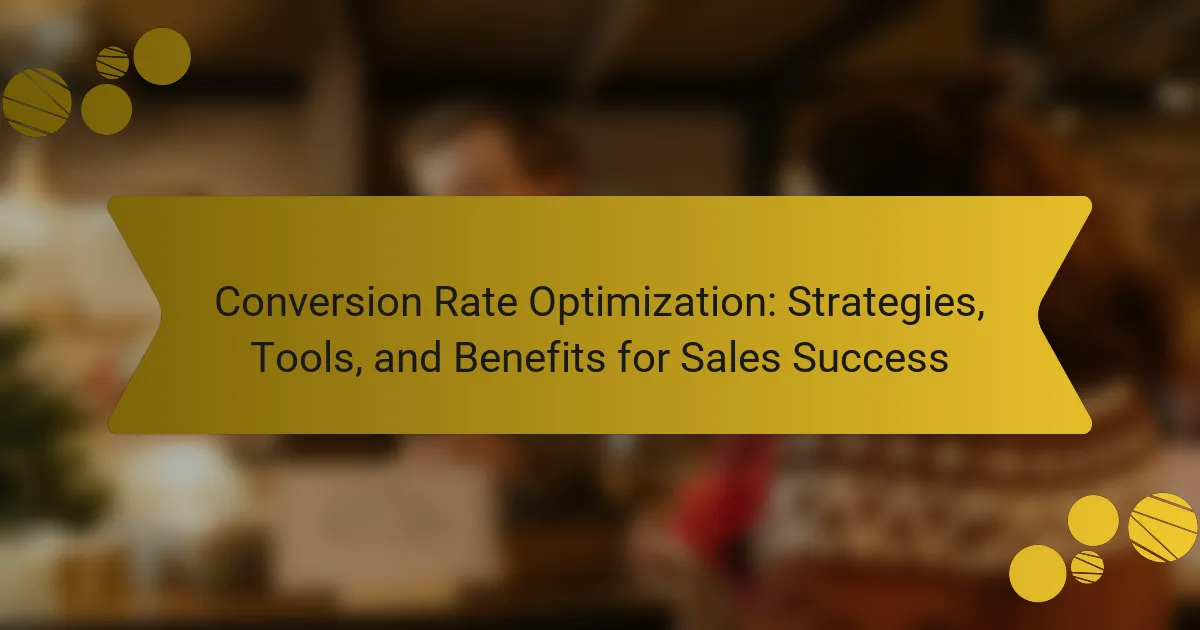Conversion Rate Optimization (CRO) is a critical process aimed at increasing the percentage of website visitors who complete desired actions, such as making purchases or signing up for newsletters. This article explores key strategies for effective CRO, including A/B testing, user experience enhancements, and optimal placement of call-to-action buttons. It also discusses various tools, such as Google Optimize and Optimizely, that facilitate data analysis and user behavior insights. Additionally, the article addresses common challenges businesses face in CRO, such as interpreting analytics data and website performance issues, emphasizing the importance of overcoming these obstacles to achieve significant sales success.
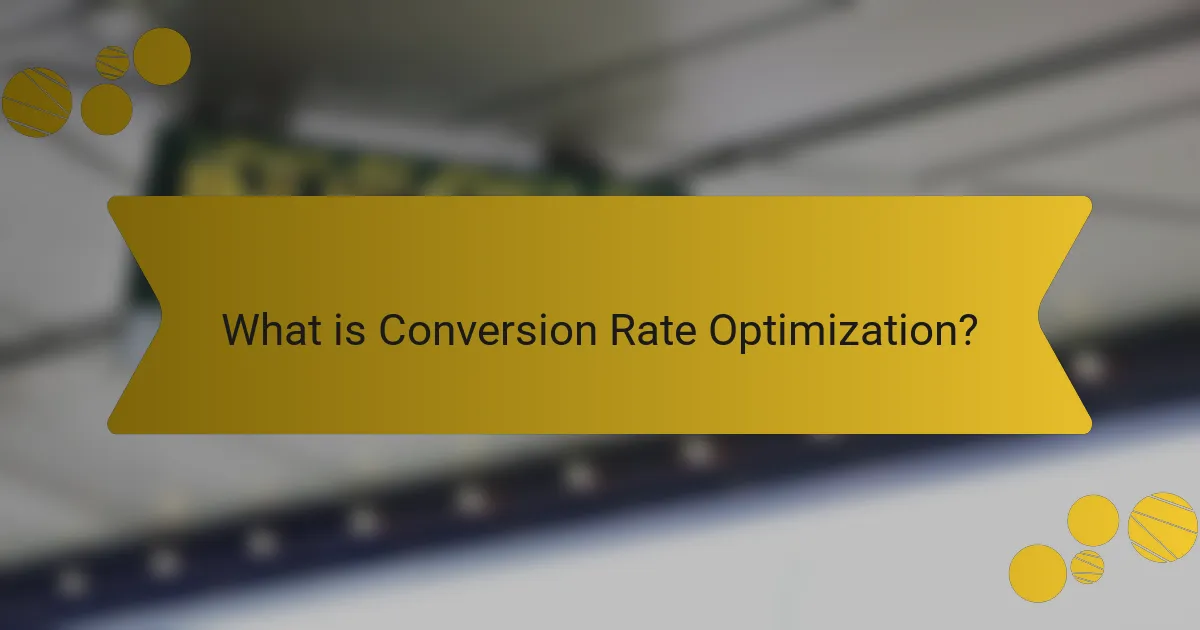
What is Conversion Rate Optimization?
Conversion Rate Optimization (CRO) is the process of increasing the percentage of website visitors who take a desired action. This action could be making a purchase, signing up for a newsletter, or filling out a contact form. CRO involves analyzing user behavior and making data-driven adjustments to improve the user experience. Techniques may include A/B testing, improving website design, and optimizing content. According to a study by Invesp, businesses that invest in CRO can see conversion rate increases of up to 300%. This demonstrates the significant impact CRO can have on sales success.
How does Conversion Rate Optimization impact sales performance?
Conversion Rate Optimization (CRO) significantly enhances sales performance by improving the percentage of visitors who make purchases. Higher conversion rates directly correlate with increased revenue. For example, a 1% increase in conversion can lead to substantial revenue growth, depending on traffic volume. Effective CRO strategies include optimizing website design, enhancing user experience, and employing targeted marketing. Research indicates that companies implementing CRO techniques see an average conversion rate increase of 20-30%. This improvement results from better alignment between customer needs and website offerings. Thus, CRO is a critical factor in maximizing sales performance.
What are the key metrics used in Conversion Rate Optimization?
Key metrics used in Conversion Rate Optimization (CRO) include conversion rate, bounce rate, and average order value. The conversion rate measures the percentage of visitors who complete a desired action. A higher conversion rate indicates effective optimization strategies. Bounce rate tracks the percentage of visitors who leave the site after viewing only one page. A lower bounce rate suggests better engagement. Average order value calculates the average amount spent per transaction. Increasing this value can lead to higher overall revenue. Other important metrics are click-through rate and customer acquisition cost. Click-through rate measures the effectiveness of calls to action, while customer acquisition cost shows the cost of gaining a new customer. These metrics provide insights into user behavior and the effectiveness of marketing efforts.
How can understanding customer behavior enhance Conversion Rate Optimization?
Understanding customer behavior enhances Conversion Rate Optimization (CRO) by allowing businesses to tailor their strategies to meet customer needs. When businesses analyze customer behavior, they can identify patterns in purchasing decisions. This insight helps in creating targeted marketing campaigns. Personalized experiences increase customer engagement and satisfaction. For example, data shows that personalized email campaigns can lead to a 29% increase in open rates. Additionally, understanding pain points allows businesses to optimize website design and navigation. A seamless user experience can significantly reduce bounce rates. Research indicates that companies focusing on customer behavior see a 10-30% increase in conversion rates. Thus, understanding customer behavior is crucial for effective CRO.
Why is Conversion Rate Optimization important for businesses?
Conversion Rate Optimization (CRO) is crucial for businesses as it directly impacts their profitability. By increasing the percentage of visitors who take desired actions, businesses can maximize their return on investment. Effective CRO strategies lead to higher sales without the need for increasing traffic. According to a study by Invesp, a 1% increase in conversion rates can significantly boost revenue. Additionally, optimizing conversion rates enhances user experience, which can lead to increased customer loyalty. Therefore, focusing on CRO is essential for sustainable business growth and improved financial performance.
What are the potential financial benefits of effective Conversion Rate Optimization?
Effective Conversion Rate Optimization (CRO) can significantly enhance a business’s financial performance. By increasing the percentage of website visitors who complete desired actions, CRO directly boosts sales revenue. For instance, a 1% increase in conversion rate can lead to substantial revenue gains, especially for high-traffic sites.
Research by Invesp indicates that companies that invest in CRO see an average return on investment of 223%. Additionally, effective CRO reduces customer acquisition costs by maximizing existing traffic, leading to improved profit margins.
Furthermore, businesses can benefit from enhanced customer retention rates, as optimized user experiences encourage repeat visits. This cumulative effect of increased conversions, reduced costs, and improved customer loyalty results in a more robust financial outcome for businesses implementing effective CRO strategies.
How does Conversion Rate Optimization contribute to customer satisfaction?
Conversion Rate Optimization (CRO) enhances customer satisfaction by improving user experience on websites. CRO focuses on making the conversion process smoother and more intuitive. This leads to reduced friction during the purchasing journey. A seamless experience increases the likelihood of customers completing their transactions. According to a study by Invesp, companies that prioritize CRO see conversion rates increase by up to 200%. Higher conversion rates indicate that customers find the process satisfactory. Satisfied customers are more likely to return and recommend the service to others. Therefore, effective CRO strategies directly correlate with elevated customer satisfaction levels.
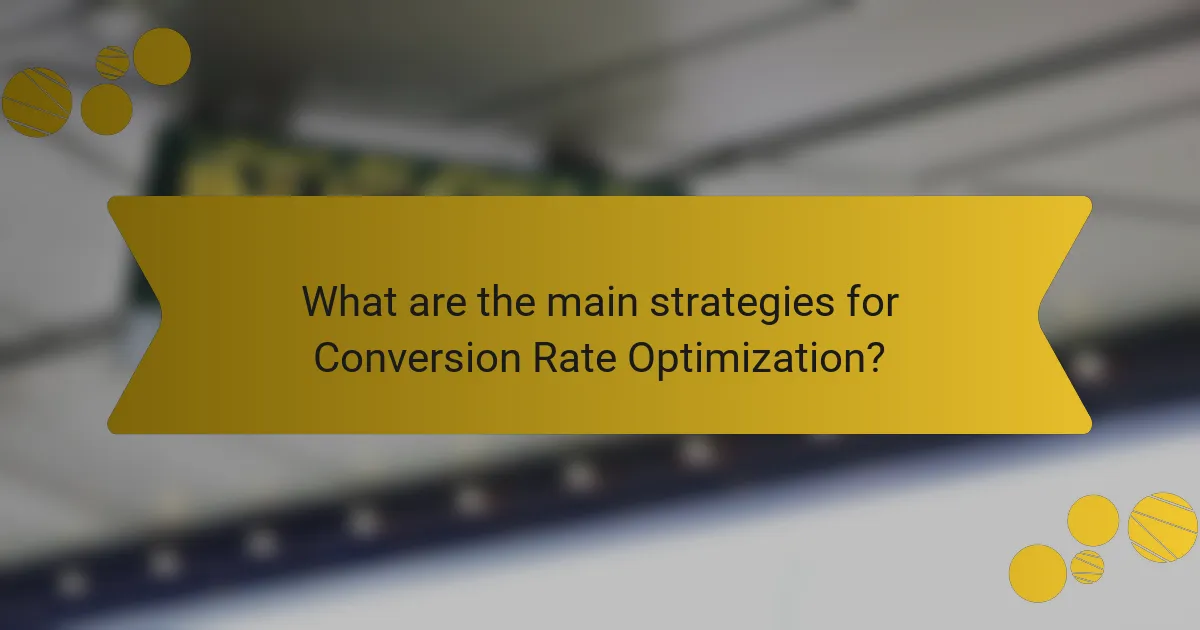
What are the main strategies for Conversion Rate Optimization?
The main strategies for Conversion Rate Optimization (CRO) include A/B testing, user experience enhancement, and targeted call-to-action (CTA) placement. A/B testing allows businesses to compare different versions of a webpage to determine which performs better. User experience enhancement focuses on improving site navigation and reducing load times. Targeted CTA placement ensures that buttons and prompts are positioned where users are most likely to engage. According to a 2021 study by Invesp, companies that implement CRO strategies can see conversion rates increase by up to 300%.
How can A/B testing be utilized in Conversion Rate Optimization?
A/B testing can be utilized in Conversion Rate Optimization (CRO) by comparing two versions of a webpage to determine which performs better. This method involves presenting one version to half of the audience and the alternative version to the other half. The goal is to measure user interactions and conversion rates for both versions.
By analyzing the data, businesses can identify which elements drive more conversions. For instance, changing a call-to-action button’s color or text can significantly impact user engagement. Research indicates that A/B testing can lead to conversion rate increases of up to 49% when optimized correctly.
This data-driven approach allows marketers to make informed decisions, enhancing overall marketing strategies. Implementing A/B testing is a fundamental practice in optimizing user experience and increasing sales success.
What elements should be tested in A/B testing for optimal results?
Elements that should be tested in A/B testing include headlines, call-to-action buttons, images, and layout. Testing different headlines can show which wording grabs more attention. Call-to-action buttons can be altered in color and text to assess their effectiveness. Images can be swapped to determine which visuals lead to better engagement. Layout changes can impact user experience and conversion rates. According to a study by Optimizely, variations in these elements can lead to significant improvements in conversion rates. Testing these elements allows marketers to optimize their strategies for better sales success.
How does A/B testing inform decision-making in Conversion Rate Optimization?
A/B testing informs decision-making in Conversion Rate Optimization by providing data-driven insights into user behavior. It allows marketers to compare two versions of a webpage or element to determine which performs better. This method involves splitting traffic between the two variants to measure key performance indicators like click-through rates or conversion rates. The results help identify which design or content resonates more with users. For example, a study by Optimizely found that A/B testing can lead to an average conversion rate increase of 49%. Thus, A/B testing enhances decision-making by minimizing guesswork and focusing on proven outcomes.
What role does website design play in Conversion Rate Optimization?
Website design plays a crucial role in Conversion Rate Optimization (CRO). Effective design enhances user experience, making navigation intuitive. Intuitive navigation reduces bounce rates and encourages users to explore more pages. A visually appealing layout captures attention and builds trust with visitors. Research shows that 94% of first impressions are design-related. Clear calls-to-action (CTAs) integrated into the design guide users toward desired actions. Mobile responsiveness is essential, as 53% of mobile users abandon sites that take longer than three seconds to load. Overall, a well-designed website directly influences conversion rates by improving usability and engagement.
How can user experience be improved to boost conversion rates?
User experience can be improved to boost conversion rates by optimizing website design and navigation. A clean and intuitive layout reduces user frustration. Fast loading times enhance user satisfaction. Clear calls-to-action guide users toward desired actions. Mobile responsiveness ensures accessibility across devices. Personalization increases relevance and engagement. A/B testing identifies effective design elements. According to a study by Google, a one-second delay in mobile load times can reduce conversions by up to 20%. Implementing these strategies leads to higher conversion rates and improved customer retention.
What design elements are most effective for enhancing conversions?
Effective design elements for enhancing conversions include clear calls-to-action (CTAs), compelling visuals, and user-friendly layouts. CTAs should be prominently placed and use action-oriented language. Compelling visuals can capture attention and convey messages quickly. User-friendly layouts ensure easy navigation and reduce bounce rates. Research shows that websites with optimized CTAs can see conversion rates increase by up to 200%. Additionally, A/B testing different design elements can provide insights into what resonates best with the target audience.
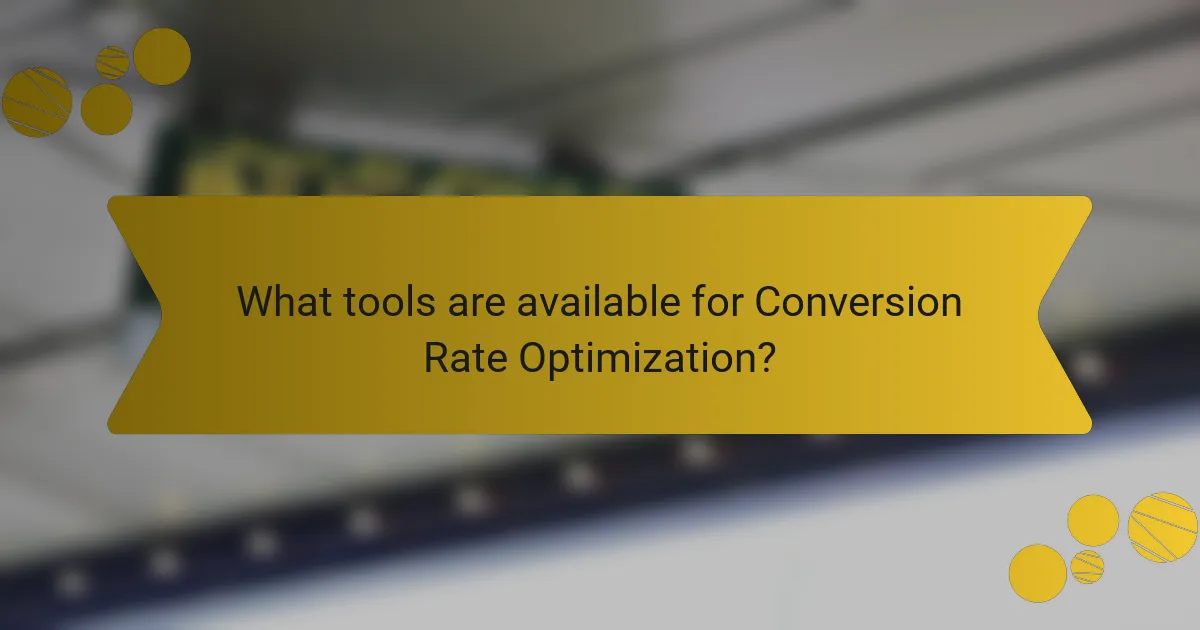
What tools are available for Conversion Rate Optimization?
Tools available for Conversion Rate Optimization include Google Optimize, Optimizely, and Unbounce. Google Optimize allows users to run A/B tests and personalize website content. Optimizely offers robust experimentation features for web and mobile applications. Unbounce specializes in creating landing pages designed for higher conversions. Other notable tools are Hotjar, which provides heatmaps and visitor recordings, and Crazy Egg, known for its visual website analytics. These tools enable businesses to analyze user behavior and improve conversion rates effectively.
Which analytics tools are essential for effective Conversion Rate Optimization?
Google Analytics is essential for effective Conversion Rate Optimization. It provides insights into user behavior on websites. This tool tracks metrics such as page views, bounce rates, and conversion rates. Additionally, it allows for the analysis of traffic sources. Heatmap tools like Hotjar enhance understanding of user interaction. They visualize where users click and scroll on a webpage. A/B testing tools such as Optimizely are crucial for testing variations of web pages. They help determine which designs or content lead to higher conversions. Finally, CRM tools like HubSpot integrate user data for deeper analysis. They assist in tracking leads and customer interactions. These tools collectively enable data-driven decisions to optimize conversion rates effectively.
How do these tools help in tracking and analyzing conversion rates?
These tools assist in tracking and analyzing conversion rates by providing real-time data on user interactions. They collect information on how visitors engage with a website or application. This data includes metrics such as page views, click-through rates, and bounce rates. Tools like Google Analytics offer insights into user behavior and conversion paths. They enable businesses to identify which marketing strategies are effective. Additionally, these tools allow for A/B testing to compare different approaches. This testing helps determine which variations lead to higher conversion rates. According to a study by HubSpot, companies that utilize analytics tools see a 5-10% increase in conversion rates on average.
What features should be prioritized when selecting Conversion Rate Optimization tools?
When selecting Conversion Rate Optimization tools, prioritize user-friendly interfaces. Tools should allow easy navigation and intuitive design for all users. Next, ensure robust analytics capabilities are included. This feature helps track user behavior and conversion metrics effectively. A/B testing functionality is also essential. It enables the comparison of different versions of web pages to optimize performance.
Integrations with existing platforms are important as well. Tools should seamlessly connect with CRM, email marketing, and analytics systems. Mobile optimization features are increasingly vital. As mobile traffic grows, tools must support mobile-friendly designs. Lastly, consider customer support and resources. Comprehensive support can enhance the tool’s effectiveness and user satisfaction.
How can marketing automation assist in Conversion Rate Optimization?
Marketing automation can significantly enhance Conversion Rate Optimization (CRO) by streamlining processes and personalizing user experiences. It allows businesses to segment their audience based on behavior and preferences. This targeted approach increases the relevance of marketing messages. Automation tools can also facilitate A/B testing to identify the most effective content and layouts. According to a study by HubSpot, companies using marketing automation see a 451% increase in qualified leads. Furthermore, automated follow-ups can nurture leads through the sales funnel, ultimately boosting conversion rates. By analyzing user data, marketing automation provides insights that inform strategy adjustments, leading to continuous improvement in CRO efforts.
What are the benefits of integrating marketing automation with Conversion Rate Optimization?
Integrating marketing automation with Conversion Rate Optimization (CRO) enhances efficiency and effectiveness in marketing efforts. Marketing automation streamlines repetitive tasks, allowing for targeted messaging based on user behavior. This targeted approach increases the likelihood of conversion by presenting relevant content to potential customers.
CRO benefits from marketing automation through data-driven insights. Automated tools analyze user interactions, identifying patterns that inform optimization strategies. For example, A/B testing can be automated, enabling quicker adjustments based on performance metrics.
Research indicates that companies using marketing automation see a 451% increase in qualified leads. This statistic underscores the effectiveness of combining these two strategies for improved sales outcomes. Additionally, marketing automation can nurture leads through personalized communication, further increasing conversion rates.
How can marketing automation improve lead nurturing for higher conversions?
Marketing automation enhances lead nurturing by streamlining communication and personalizing interactions. It allows businesses to segment leads based on behavior and preferences. This targeted approach increases engagement rates. Automated workflows can send timely follow-ups, ensuring leads receive relevant information when needed. According to a study by HubSpot, automated lead nurturing can lead to a 451% increase in qualified leads. Additionally, marketing automation tools provide analytics to measure the effectiveness of campaigns. This data-driven insight allows for continuous optimization of strategies. Ultimately, these factors contribute to higher conversion rates.
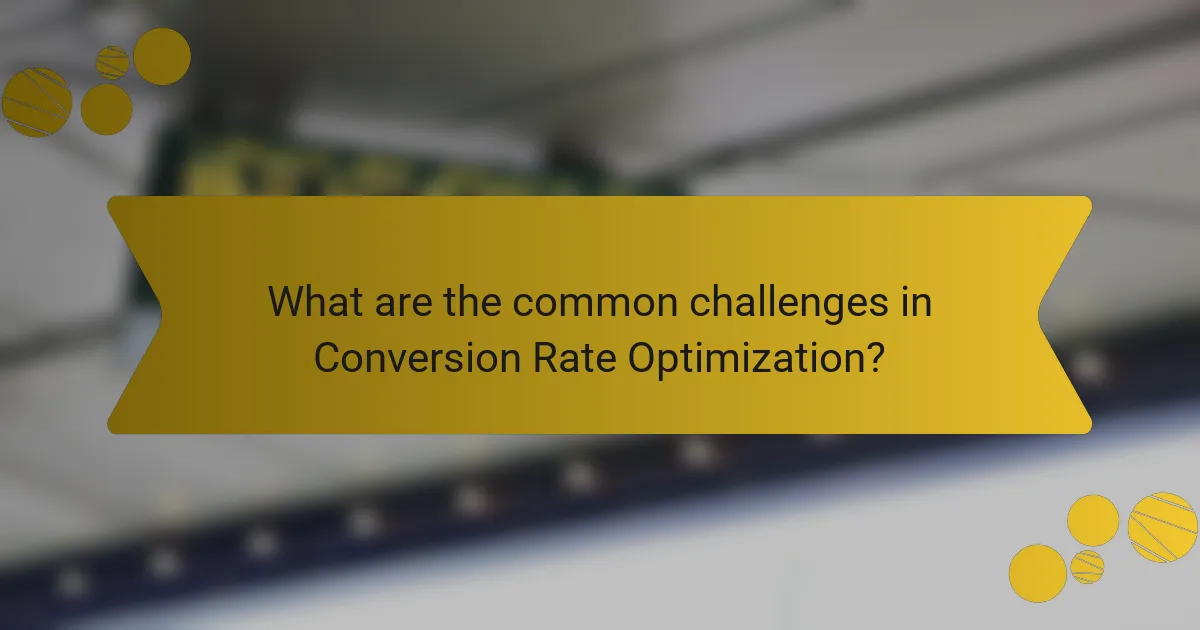
What are the common challenges in Conversion Rate Optimization?
Common challenges in Conversion Rate Optimization include understanding user behavior, lack of data, and website performance issues. Understanding user behavior is crucial for tailoring strategies effectively. Many businesses struggle to interpret analytics data accurately. This can lead to misguided optimization efforts. Additionally, insufficient data can hinder the ability to make informed decisions. Without comprehensive insights, identifying areas for improvement becomes challenging. Website performance issues, such as slow loading times, also negatively impact conversion rates. Research indicates that a one-second delay can reduce conversions by 7%. These challenges must be addressed to improve overall conversion rates successfully.
Why do businesses struggle with implementing Conversion Rate Optimization strategies?
Businesses struggle with implementing Conversion Rate Optimization (CRO) strategies due to a lack of understanding and expertise. Many companies do not have personnel trained in data analysis or user experience design. This knowledge gap leads to ineffective strategy development. Additionally, businesses often face resource constraints, limiting their ability to conduct thorough testing. According to a 2021 report by Econsultancy, 70% of companies lack a documented CRO strategy. This absence results in inconsistent approaches to optimization. Furthermore, businesses may not prioritize CRO amid other marketing efforts. This can lead to missed opportunities for improving conversion rates.
What are the most frequent pitfalls to avoid in Conversion Rate Optimization?
Common pitfalls to avoid in Conversion Rate Optimization include neglecting user experience. Poor website design can deter potential customers. Another pitfall is failing to define clear goals. Without specific objectives, measuring success becomes challenging. Additionally, overcomplicating the conversion process can lead to user frustration. Streamlined processes typically yield higher conversion rates. Ignoring data analysis is also a frequent mistake. Data-driven decisions are essential for effective optimization. Lastly, not testing variations can hinder improvement. A/B testing is crucial for understanding what works best. These pitfalls can significantly impact conversion success.
How can organizations overcome resistance to change during Conversion Rate Optimization?
Organizations can overcome resistance to change during Conversion Rate Optimization by fostering a culture of open communication. This involves actively engaging team members in discussions about the changes and their benefits. Providing clear data and case studies demonstrating successful outcomes can help alleviate concerns. Training sessions can empower employees with the skills needed to adapt to new processes. Additionally, involving key stakeholders in the decision-making process creates a sense of ownership. Recognizing and rewarding early adopters can motivate others to embrace change. Research shows that organizations with strong change management practices see a 70% success rate in change initiatives.
What best practices should be followed for successful Conversion Rate Optimization?
Successful Conversion Rate Optimization (CRO) involves several best practices. First, define clear goals for your conversion process. This helps in measuring success effectively. Second, utilize A/B testing to compare different versions of your website or landing pages. Studies show that A/B testing can increase conversion rates by up to 49%. Third, analyze user behavior through tools like heatmaps and session recordings. This provides insights into how users interact with your site. Fourth, improve website loading speed. Research indicates that a one-second delay can reduce conversions by 7%. Fifth, ensure mobile optimization. With over 50% of web traffic coming from mobile devices, a mobile-friendly site is crucial. Lastly, create compelling calls to action (CTAs). Effective CTAs can increase click-through rates significantly. Following these practices can lead to improved conversion rates and enhanced sales success.
How can continuous testing and iteration enhance Conversion Rate Optimization efforts?
Continuous testing and iteration significantly enhance Conversion Rate Optimization (CRO) efforts by providing data-driven insights. This process allows businesses to identify what elements of their marketing strategies are effective. Through A/B testing, companies can compare different versions of web pages or advertisements. This comparison reveals which variations lead to higher conversion rates.
Iteration based on test results enables continuous improvement. It allows marketers to refine their approaches based on real user behavior. Research indicates that companies implementing continuous testing see conversion rate increases of up to 30%. This improvement stems from making informed decisions rather than relying on assumptions.
Moreover, continuous testing fosters a culture of experimentation. It encourages teams to innovate and adapt to changing consumer preferences. This adaptability is crucial in a competitive market. Overall, continuous testing and iteration create a systematic approach to optimizing conversion rates effectively.
What role does customer feedback play in refining Conversion Rate Optimization strategies?
Customer feedback is crucial in refining Conversion Rate Optimization (CRO) strategies. It provides insights into user preferences and pain points. Analyzing this feedback helps identify areas for improvement on websites or landing pages. For instance, a study by HubSpot found that companies using customer feedback to inform their CRO efforts saw a 30% increase in conversion rates. Feedback can guide A/B testing decisions, ensuring that changes align with user expectations. Furthermore, it fosters a customer-centric approach, enhancing overall user experience. This iterative process of integrating feedback leads to more effective CRO strategies.
Conversion Rate Optimization (CRO) is the systematic process aimed at increasing the percentage of website visitors who complete desired actions, such as making purchases or signing up for newsletters. This article covers essential strategies for effective CRO, including A/B testing, user experience enhancement, and targeted call-to-action placement, along with the importance of understanding customer behavior and utilizing key metrics. Additionally, it explores the financial benefits of CRO, the role of marketing automation, and the common challenges businesses face in implementing these strategies. Tools for tracking and analyzing conversion rates are also discussed, providing a comprehensive overview of how optimizing conversion rates can lead to improved sales performance and customer satisfaction.
